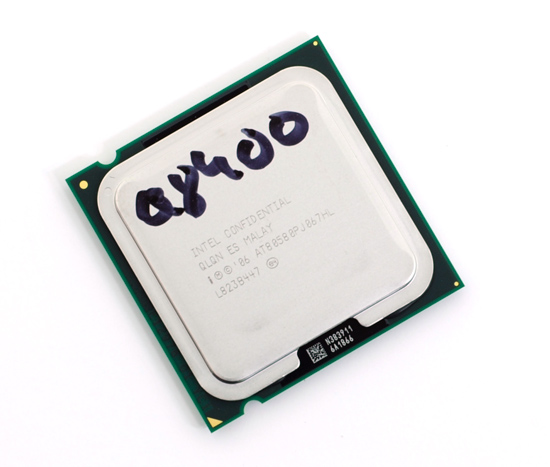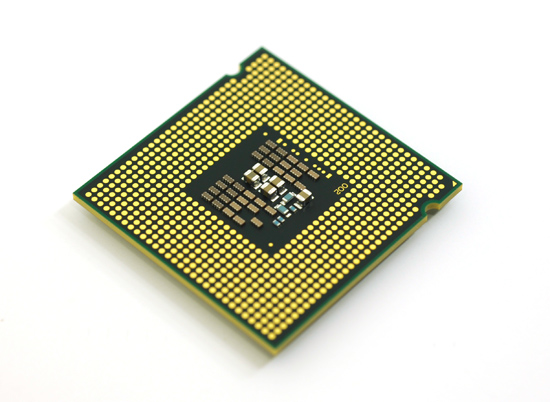The Core 2 Quad Q8400: Intel's $183 Phenom II 940 Competitor
by Anand Lal Shimpi on May 7, 2009 12:00 AM EST- Posted in
- CPUs
I’ve been writing about the “new” Intel for nearly three years now. It’s been so long that I almost forgot what the old Intel was like. It’s not that the old Intel wasn’t competitive performance-wise, it’s that the old Intel wasn’t pleasant to work with. The old Intel was the one that always thought the Pentium 4 was the fastest thing on the planet, even when it wasn’t. The old Intel wasn’t forthcoming with information and acted like it worked in a world where it had no competition. The old Intel wasn’t a very good Intel.
The new one is nothing like that. We get open sharing of information, real discussion about AMD’s strengths and weaknesses and it also helps that we also get the world’s fastest microprocessors with it.
We’ve seen that the new Intel can stand the test of time, at least over the past three years. But can the new Intel last when it’s not always winning reviews? Sure, Intel’s Core i7 remains untouched but what about at cheaper price points? Last month we found out that Intel is quite competitive at the $70 with its Pentium E5300. But between the $70 E5300 and the $280 Core i7-920 there are a few price points where AMD is recommendable.
The question then becomes how does the new Intel deal when it isn’t the fastest on the market?
Surprisingly well it turns out.
This is the Core 2 Quad Q8400:

It’s a quad-core chip running at 2.66GHz with a 2MB L2 per pair of cores (4MB total). It’s like two Pentium Dual Core processors on a single package.
These chips actually have a 6MB L2 but with 2MB disabled either because they have irrecoverable defects in the cache or simply to hit the right price point. In other words, the Q8400 is literally a Q9400 but with 2MB of its L2 disabled.

The Q8400 is Intel’s most recent response to the Phenom II X4 940. Initially AMD priced the 940 similarly to the Q9400. Then, Intel cut prices so that the 940 had to compete with the much faster Q9550. AMD responded, with a price cut that put the 940 on par with the Q9400 again.
Once AMD began shipping Socket-AM3 Phenom IIs, it dropped the prices on its Socket-AM2+ parts once more. This wasn’t so much a price cut but rather a gradual phasing out of the AM2+ CPUs, eventually I expect an AM3-only market since those chips can also work in AM2+ boards.
Rather than take the bait and drop the Q9400 prices once more, Intel instead responded with the introduction of a similarly priced Q8400 at $183.
AMD’s Phenom II X4 940 was generally the same speed if not faster than Intel’s Core 2 Quad Q9400. With less cache, the Q8400 shouldn’t perform any better than the Q9400, so the question is - does it perform any worse?
Then there’s power consumption to worry about and overclocking, but we’ll get to those in due time. Let’s just say that the situation is far more complex than it seemed at first sight.










60 Comments
View All Comments
erple2 - Saturday, May 9, 2009 - link
while there may be fewer defects per wafer, there are also fewer chips per wafer (about 57% fewer). To take the analogy to the extreme, lets say that AMD makes one chip that consumes the entire wafer, and Intel can make 2. If there is, on average, 1 defect per wafer for AMD and 5 defects per wafer for Intel, AMD has zero good chips per wafer, and Intel has (on average), 2 good chips per 5 wafers. That example is horribly contrived, sure, but I used it to show that even having a better process (fewer defects per wafer) doesn't guarantee a good result if the size of the chunks you use on the wafer is significantly larger - AMD's can fit quite a few less per wafer (about half?).erple2 - Saturday, May 9, 2009 - link
arg... edit button... Intel would have 1 good chip per 3 wafers. I assumed 4 defects per wafer, not 5 in the 2/5 ...slayerized - Thursday, May 7, 2009 - link
You are confusing yield and throughput - they are two different things.8steve8 - Thursday, May 7, 2009 - link
no Virtualization Tech... so no windows 7 virtual PC, no hyper-v...that sucks.
rather go phenom 2, intel e8xxx or q9xxx
ltcommanderdata - Friday, May 8, 2009 - link
I don't think the lack of VT will be a huge issue for the average consumer. The Q8400 is a budget quad core and OEMs will no doubt be bundling Windows 7 Home Premium with it which doesn't support XP Mode anyways. Tech savy buyers who build their own computers with a Q8400 and Professional Edition would notice, but the larger impediment to XP Mode adoption is probably still Microsoft's production edition matrix.Anand Lal Shimpi - Thursday, May 7, 2009 - link
Very good point, I've updated the conclusion to point out the difference. Honestly it's ridiculous that Intel isn't enabling it on these chips.Take care,
Anand
spazmedia - Thursday, May 7, 2009 - link
I second this. Just bought a intel box with an E5200 thinking it had VT. Hopefully they will follow AMD's lead.GeorgeH - Thursday, May 7, 2009 - link
+1No support for Windows 7 XP Mode is the reason I chose AMD over an Intel Q8X00 in the PC I just built.
leomax999 - Thursday, May 7, 2009 - link
Intel has announced vt support for Q8300, E7400, E7500, E5300, E5400.So i dont see any reason why q8400 shouldnt get it.
http://www.tcmagazine.com/comments.php?shownews=25...">http://www.tcmagazine.com/comments.php?shownews=25...
GeorgeH - Thursday, May 7, 2009 - link
Thanks for the link, but to be clear the chips you listed will never support VT.Intel is supposed to be releasing Q8300".1", E7400".1", etc. chips, but unless they change the model number I can only see that leading to mass confusion. Forcing average people to check the S-Spec or MM number against a list to see what they're actually getting is a classic recipe for fail.
Until those updated Intel chips hit the market, AMD will remain the only real choice for budget and midrange quad core.